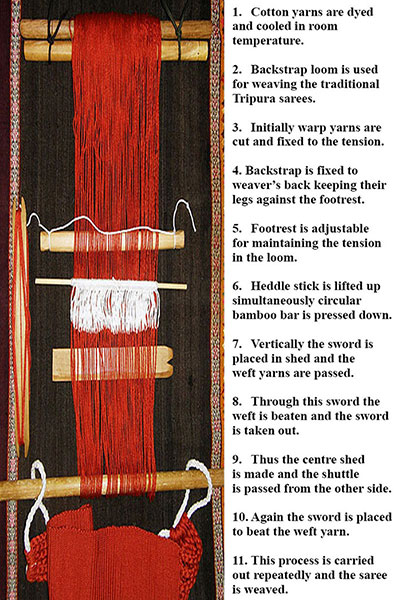Design Resource
Traditional Saree Weaving - Agartala, Tripura
Tripuri Handicraft
by
The art of weaving Tripura traditional saree gets initiated by the dyeing process. Water is boiled at a high temperature, and the required colour is added to it. The water is stirred thoroughly to mix the colour well in water. Cotton yarns are soaked in cold water first and arranged on the rods. These yarns are held tight together and dipped thoroughly in coloured boiling water. Multiple times of dipping the yarns are done to spread the colour uniformly. Once the yarns are dyed, they are taken out from the coloured boiling water and hung inside the room. It is allowed to dry completely at room temperature.
Further, these yarns are used for weaving the traditional Tripura saree. The backstrap loom is used in Tripura for weaving the saree. All the operations are done manually here. Warp yarns are cut as per the length of fabric and fixed inappropriate tension. Two loops present in the ends of the back strap are attached to the notches of the front bar. In this sort of loom, all types of weaves can be woven. There are numerous possibilities to weave a variety of patterns. The backstrap is fixed to the weaver’s back, keeping their legs against the footrest. This footrest is adjustable for maintaining the tension in the loom. Weaving in the backstrap loom consists of shedding motion, picking motion, and beating motion.
The heddle stick is simultaneously lifted in the left hand; a circular bamboo bar is pressed down with the right hand. Vertically the sword is placed in the shed, and the weft yarns passed from the right side using the right hand through shuttle and picked up by the left hand. Through this sword, the weft is beaten, and the sword is taken out. Thus the center shed is made, and the shuttle is passed from the left side to the right side. Again the sword is placed to beat the weft yarn. This process is carried on repeatedly. When the weaving gets to begin, two bamboo splits work. This process continues until the pattern is woven. Patterns like colourful stripes run in the direction of the warp, and the geometric motifs are woven in the direction of the weft. These patterns, designs, and colouring all vary from tribe to tribe.
Flow Chart:















